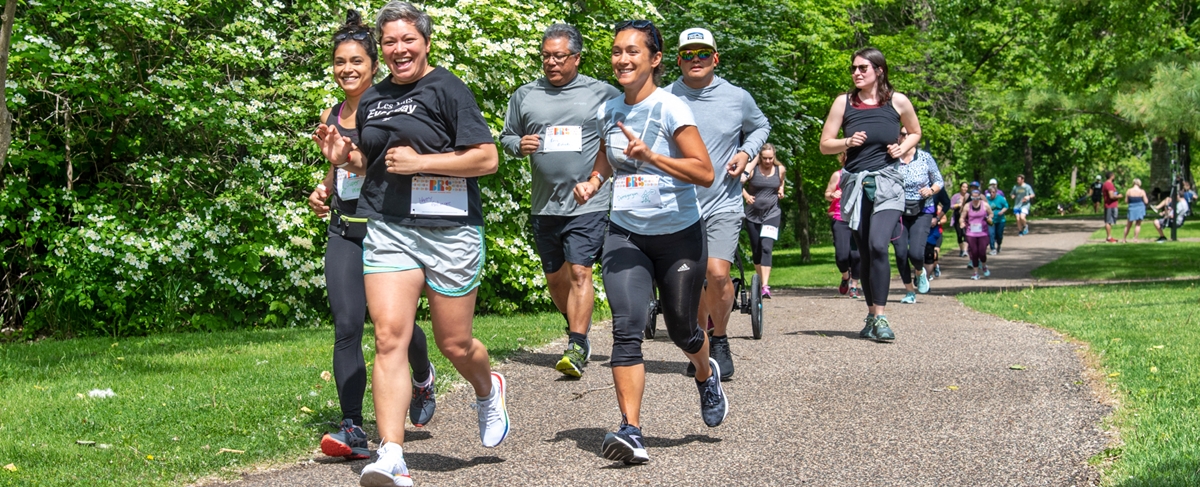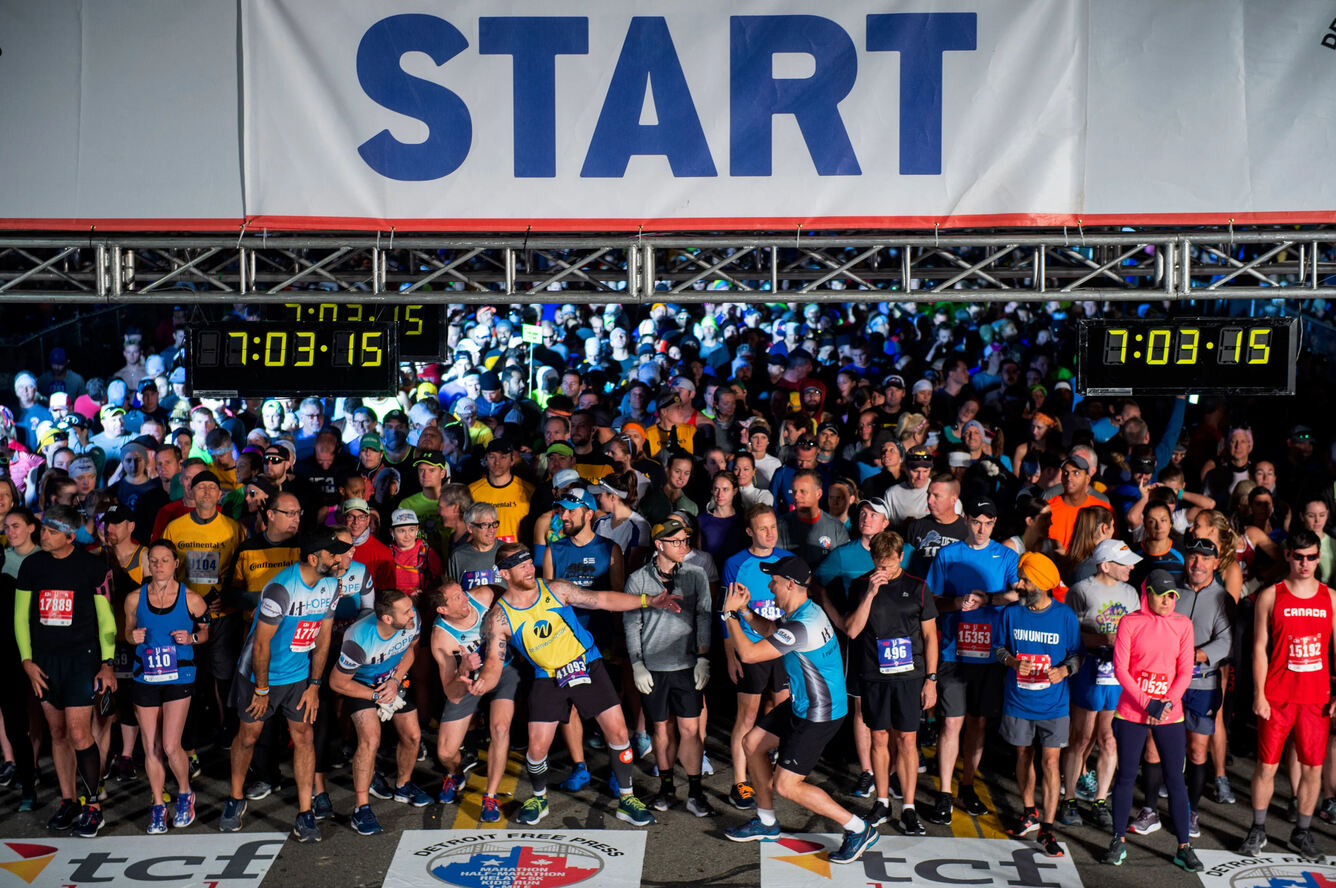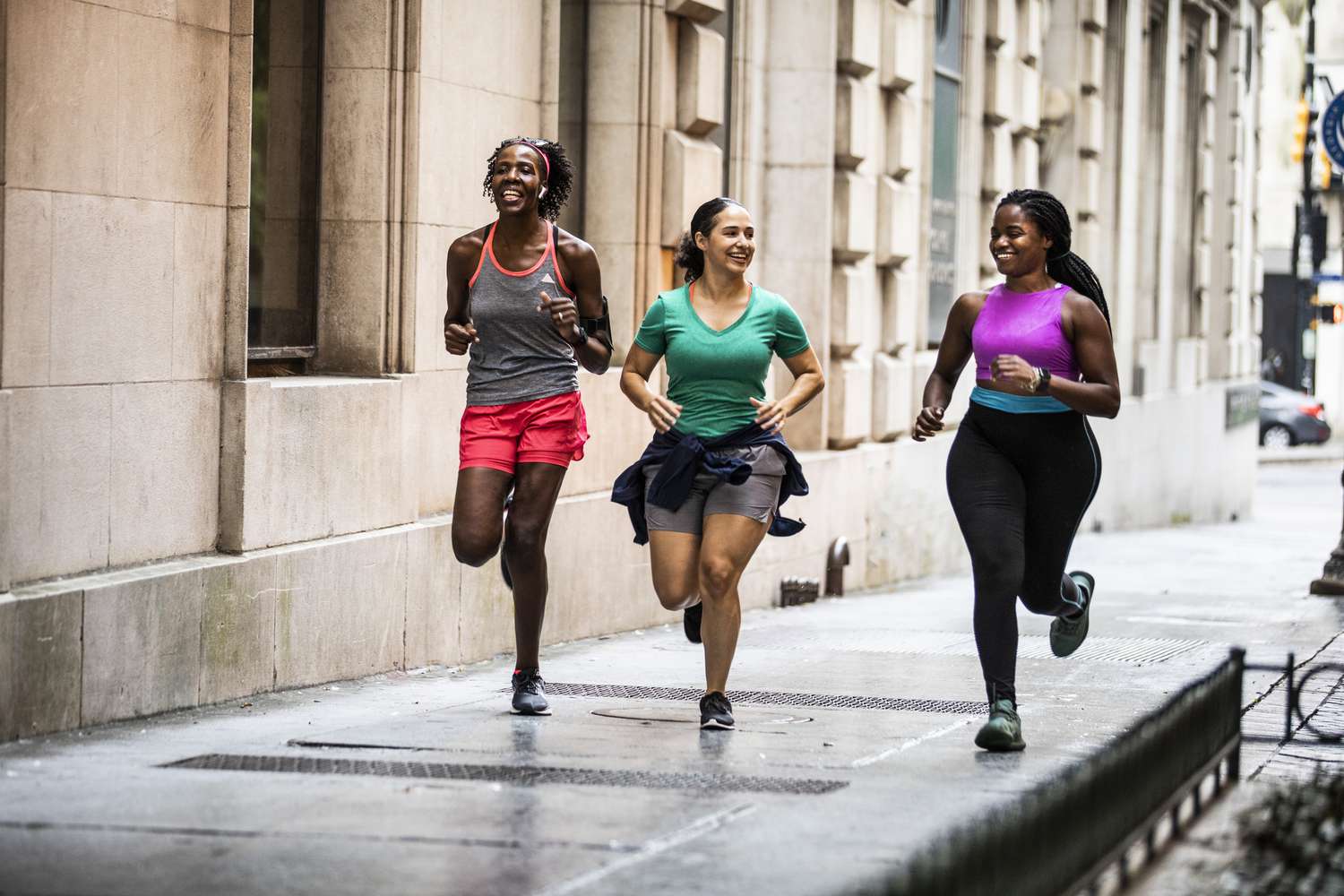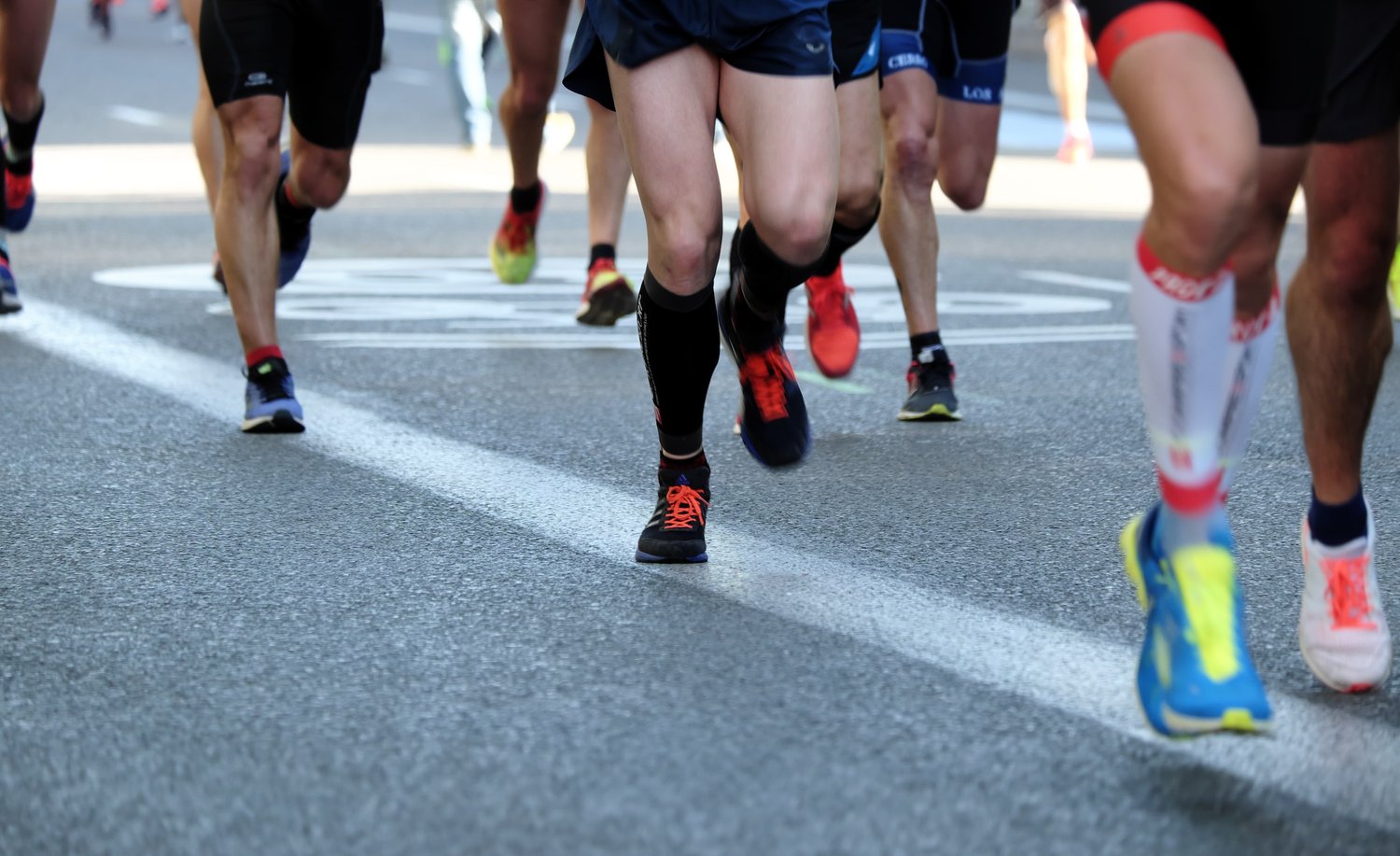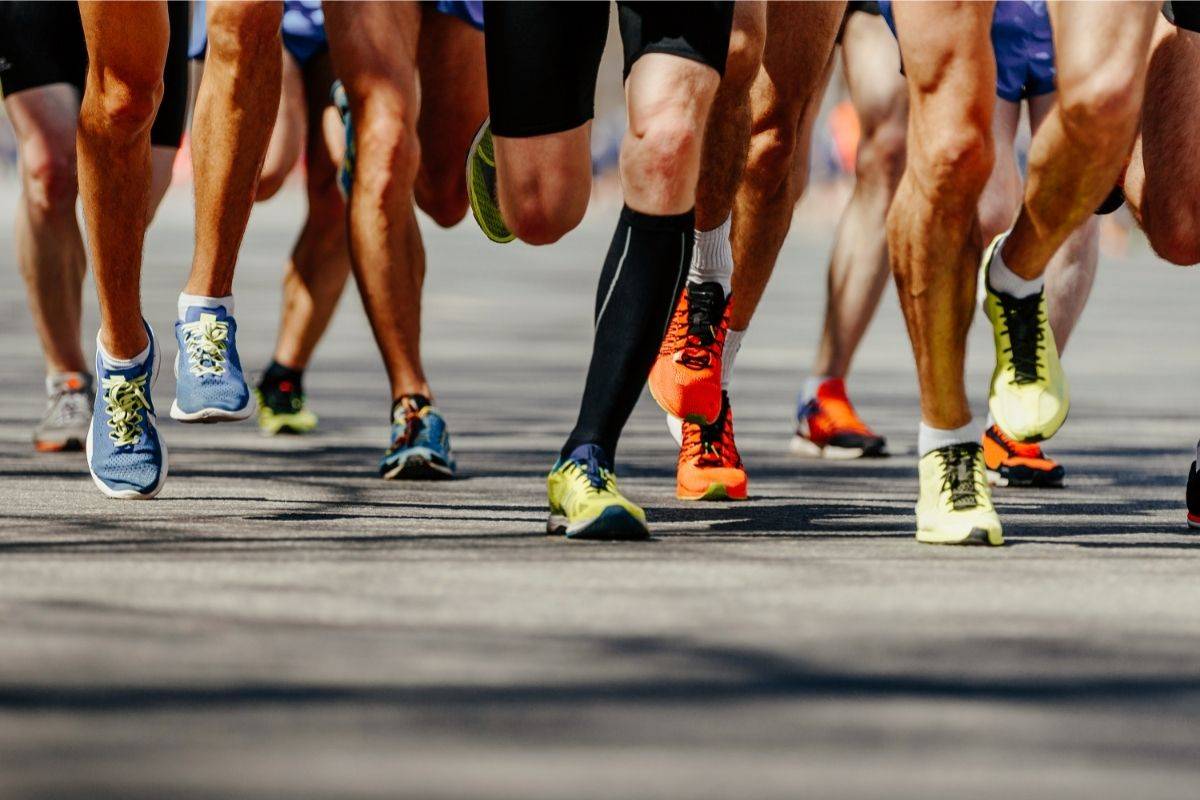

Featured
How To Host A 5K Run Fundraiser
Modified: August 19, 2023
Learn how to organize a successful 5K run fundraiser and make your event stand out with our featured guide. Start raising funds now!
Introduction
Welcome to the exciting world of hosting a 5K run fundraiser! If you’re passionate about making a positive impact in your community and raising funds for a worthy cause, organizing a 5K run is a fantastic way to achieve both goals. A 5K run not only promotes a healthy lifestyle but also brings people together for a shared purpose.
Whether you’re a seasoned event planner or a first-time organizer, this comprehensive guide will provide you with all the information you need to host a successful 5K run fundraiser. From choosing a cause to planning the logistics, we’ll walk you through each step of the process.
Hosting a 5K run fundraiser requires careful planning, attention to detail, and a dedicated team of volunteers. The rewards, however, are tremendous. Not only will you raise funds for a cause close to your heart, but you’ll also create an unforgettable experience for participants and make a lasting impact in your community.
Throughout this guide, we’ll cover various aspects of organizing a 5K run fundraiser, including selecting a cause, forming a planning committee, setting a budget, securing sponsorship, obtaining permits and insurance, choosing a venue, marketing and promotion, registration process, volunteer recruitment, course planning, safety precautions, event equipment and supplies, the day of the event, and post-event tasks.
By following the tips and suggestions provided in this guide, you’ll be well-equipped to host a memorable and successful 5K run fundraiser. So, let’s dive in and start planning your incredible event that will not only bring the community together but also make a difference in the lives of others.
Choosing a Cause
When it comes to organizing a 5K run fundraiser, choosing a cause that resonates with you and your community is of utmost importance. The cause will serve as the driving force behind your event, inspiring participants to get involved and make a difference. Here are some steps to help you select the perfect cause for your 5K run fundraiser:
- Identify your passions: Reflect on the issues and causes that are close to your heart. It could be a local charity, a disease research organization, or a social cause. Choose something that you feel deeply about and genuinely want to support.
- Research local needs: Look into the prevalent needs and challenges in your community. Identify areas where your 5K run fundraiser can have the most significant impact. Consider partnering with a local nonprofit organization to ensure your efforts are aligned with the community’s needs.
- Involve the community: Engage the community in the decision-making process. Conduct surveys or hold meetings to gather opinions and suggestions. This will not only create a sense of ownership but also ensure that the cause you choose resonates with a wide range of participants.
- Evaluate the impact: Assess the potential impact your 5K run fundraiser can have on the chosen cause. Consider the funds raised, the awareness generated, and the long-term effects of your event. Aim for a cause where your efforts can make a meaningful and lasting difference.
- Consider local partnerships: Explore partnerships with local businesses, community leaders, and organizations that are already working on related causes. Collaborating with established entities can amplify your impact and provide valuable resources and support.
Remember, choosing a cause is about more than just raising funds – it’s about creating a meaningful connection with your community and inspiring change. Selecting a cause that aligns with your values and has a tangible impact will motivate and engage participants, making your 5K run fundraiser a resounding success.
Planning Committee
Organizing a 5K run fundraiser is a big undertaking, and it’s essential to assemble a capable planning committee to ensure its success. A strong committee will bring diverse skills, experience, creativity, and dedication to the table. Here are some steps to establish an effective planning committee:
- Identify key roles: Determine the key roles needed for the planning committee, such as event coordinator, marketing and promotions, volunteer coordinator, logistics manager, fundraising lead, and sponsorship coordinator. Assign individuals who have the necessary skills and experience for each role.
- Recruit committed individuals: Reach out to your network, community organizations, and local universities to find individuals who are passionate about the cause and willing to devote their time and energy to the event. Look for people with event planning, marketing, fundraising, and organizational skills.
- Hold an initial meeting: Bring the committee members together for an initial meeting to share the vision, goals, and responsibilities of the event. Discuss each member’s role and establish clear expectations and timelines. This meeting is also an opportunity to gauge the commitment and enthusiasm of the team.
- Delegate tasks: Break down the various aspects of event planning into smaller tasks and assign them to committee members. Establish regular meetings and provide a framework for communication and collaboration. Encourage transparency and open communication among the team.
- Encourage creativity and collaboration: Foster an environment where committee members feel comfortable sharing ideas, brainstorming, and collaborating. Encourage creativity and out-of-the-box thinking to make the event stand out.
- Provide support and resources: Ensure that the committee members have access to the necessary resources and support to carry out their responsibilities. This may include event planning tools, marketing materials, and fundraising guidance.
A well-functioning planning committee can make all the difference in the success of your 5K run fundraiser. The combined efforts, ideas, and expertise of the committee members will help create a seamless and memorable event that drives participation and achieves fundraising goals. Remember to recognize and appreciate the hard work of your committee members throughout the planning process to maintain motivation and teamwork.
Setting a Budget
Setting a budget is a crucial step in organizing a 5K run fundraiser. It ensures that you have a clear understanding of the financial resources required and allows you to make informed decisions throughout the planning process. Here are some steps to help you set a budget for your event:
- Define your financial goals: Determine how much money you aim to raise through the 5K run fundraiser. This will serve as a guiding factor in determining your budget and fundraising targets.
- List all expenses: Make a comprehensive list of all the expenses you anticipate for the event. This may include permit fees, insurance, venue rental, marketing materials, t-shirts, medals, refreshments, timing systems, and any other logistical and operational costs.
- Research costs: Research and gather quotes from suppliers, vendors, and service providers to get an idea of the costs associated with each expense category. This will help you ensure that your budget is realistic and accurate.
- Allocate funds strategically: Prioritize your expenses and allocate funds strategically based on their impact on the event. For example, spending more on marketing and promotions can help drive participation and increase donations.
- Consider additional revenue streams: Explore opportunities for additional revenue streams to supplement your fundraising efforts. This could include sponsorship packages, merchandise sales, or team registration fees. These additional revenue sources can offset some of your expenses.
- Track and monitor expenses: Create a system for tracking and monitoring your expenses to ensure that you stay within budget. Keep a detailed record of all income and expenditure, and regularly review your budget to make adjustments as needed.
Remember, setting a budget requires careful consideration and a realistic assessment of your financial resources. It is important to strike a balance between your fundraising goals and your expenses to ensure that your 5K run fundraiser is both successful and financially responsible.
Securing Sponsorship
Sponsorship plays a pivotal role in the success of a 5K run fundraiser. It not only provides financial support but also lends credibility to your event and opens doors to valuable resources. Securing sponsorship requires a strategic approach and effective communication. Here are some steps to help you secure sponsors for your 5K run:
- Create a sponsorship package: Develop a comprehensive sponsorship package that outlines the benefits and opportunities for potential sponsors. This package should include different tiers of sponsorship with corresponding levels of exposure, such as logo placement on event materials, social media mentions, and a booth at the event.
- Identify potential sponsors: Research and identify local businesses, corporations, and organizations that align with your cause or have a vested interest in the community. Consider the demographics and interests of your target audience, and seek sponsors that can resonate with them.
- Make a compelling pitch: Craft a compelling pitch that highlights the benefits of sponsoring your 5K run. Clearly outline how their support will align with their marketing objectives, enhance their brand visibility, and demonstrate their commitment to the community.
- Personalize your approach: Tailor your sponsorship proposals to each potential sponsor, highlighting how their specific products, services, or values align with your event and cause. Show that you have taken the time to understand their brand and how they can benefit from the sponsorship.
- Offer unique opportunities: Think beyond traditional forms of sponsorship and offer unique opportunities to stand out. This can include branded merchandise, special mentions during the event, or exclusive access to participants or attendees.
- Follow up and nurture relationships: Create a system for following up with potential sponsors and nurturing the relationship. Keep track of conversations and commitments, and express gratitude for their consideration and support.
- Recognize and appreciate sponsors: Once you secure sponsors, make sure to fulfill your promises and provide the agreed-upon benefits. Publicly acknowledge and express appreciation for their support during the event and in post-event communication.
Remember, securing sponsors requires persistence, effective communication, and a mutually beneficial partnership. Show potential sponsors the value of aligning with your event and cause, and demonstrate that their support will have a meaningful impact on the community. A strong sponsorship base will not only provide financial support but also elevate the success and visibility of your 5K run fundraiser.
Obtaining Permits and Insurance
Obtaining the necessary permits and insurance is a critical step in ensuring the legality and safety of your 5K run fundraiser. Failure to comply with local regulations and secure appropriate insurance coverage can result in legal implications and put the event and participants at risk. Here are some steps to help you navigate this process:
- Research local regulations: Familiarize yourself with the local regulations and requirements for organizing public events, specifically 5K runs. Contact the appropriate authorities, such as the local city or county clerk’s office, to gain a clear understanding of the permits and licenses needed.
- Submit permit applications: Once you have identified the necessary permits, complete and submit the required application forms to the relevant authorities. Be prepared to provide details about your event, including the date, location, estimated number of participants, and any additional information requested.
- Secure event insurance: Acquire event insurance that covers liability and other potential risks associated with your 5K run. Consult with insurance providers who specialize in event coverage to ensure that you have sufficient protection in place.
- Consider participant waivers: Implement participant waivers, which are legal agreements that participants sign to acknowledge and accept any potential risks associated with participating in the 5K run. Consult with legal professionals to ensure that your waiver is legally binding and covers all necessary aspects.
- Communicate with local authorities: Maintain open lines of communication with the local authorities responsible for granting permits. Address any questions or concerns they may have promptly and provide the requested documentation or modifications, if necessary.
- Observe safety protocols: Alongside permits and insurance, prioritize the safety of your participants and volunteers. Develop a comprehensive safety plan that includes measures such as traffic control, first aid stations, emergency procedures, and sufficient hydration stations along the course.
- Keep documentation organized: Maintain a record of all permit applications, insurance policies, approvals, and communications related to permits and insurance. This documentation will be valuable for future reference and may be required for audit purposes.
By obtaining the required permits and insurance, you demonstrate your commitment to hosting a safe and lawful 5K run fundraiser. Stay informed about local regulations, ensure proper insurance coverage, and prioritize participant safety to create a successful and worry-free event.
Selecting the Venue
Choosing the right venue is crucial for the success of your 5K run fundraiser. The venue sets the stage for the event and can impact factors such as participant experience, logistics, and overall atmosphere. Here are some factors to consider when selecting the venue for your 5K run:
- Size and capacity: Assess the size of the venue and its capacity to accommodate the expected number of participants, spectators, and support staff. Ensure there is enough space for the start and finish lines, restrooms, parking, and any other amenities necessary for a smooth event.
- Accessibility: Consider how easily participants and spectators can access the venue. Look for convenient transportation options, ample parking, and accessibility for participants with disabilities. Accessibility will enhance the participation and overall experience for all attendees.
- Course suitability: Evaluate the venue’s surroundings and determine if it offers a suitable course for a 5K run. Look for flat and well-maintained paths, minimal traffic interference, and scenic views that can enhance the event experience for participants.
- Amenities and facilities: Take note of the amenities and facilities available at the venue. Consider factors such as restrooms, changing rooms, seating areas, water stations, and space for vendors or exhibitors if applicable. These amenities will contribute to the overall satisfaction of participants and spectators.
- Cost and availability: Consider the cost of renting the venue and whether it aligns with your budget. Plan ahead and secure the venue well in advance to ensure availability on your desired event date. Explore potential discounts or sponsorships from the venue to reduce costs.
- Permit requirements: Verify if the venue requires any specific permits or permissions to host your 5K run. Be aware of any local regulations that may limit or regulate events in certain areas or venues. Prioritize venues that already have necessary permits in place to simplify the process.
- Local support: Evaluate the level of support you can expect from the venue staff and local authorities. It can greatly contribute to the smooth execution of the event, as their experience and cooperation will assist in addressing any logistical or safety concerns.
By considering these factors, you can choose a venue that meets the specific needs of your 5K run fundraiser. A well-chosen venue will enhance the participant experience, facilitate logistics, and contribute to the overall success of the event.
Marketing and Promotion
Effective marketing and promotion are essential to ensure maximum participation and fundraising success for your 5K run fundraiser. By reaching out to the right audience and creating a buzz around your event, you can generate excitement and encourage community engagement. Here are some strategies to help you market and promote your 5K run:
- Create a marketing plan: Develop a comprehensive marketing plan that outlines your goals, target audience, messaging, and promotional channels. Consider both online and offline marketing strategies to reach a wide range of potential participants.
- Establish an online presence: Build a dedicated event website or landing page where participants can find all the necessary information and register for the event. Utilize social media platforms to share updates, engage with your audience, and encourage sharing through hashtags and contests.
- Collaborate with local influencers: Identify influential individuals and organizations in your community who can help promote your 5K run. Partner with them to create collaborative content, host giveaways, or feature them as event ambassadors.
- Create compelling content: Develop engaging content that highlights the purpose of your event, the cause you support, and the unique aspects of your 5K run. Leverage a mix of written, visual, and video content to engage your audience and communicate the value of participation.
- Utilize email marketing: Build an email list of potential participants, sponsors, and volunteers and send regular updates, reminders, and incentives. Personalize your emails to make recipients feel valued and connected to the cause.
- Collateral and promotional materials: Design eye-catching posters, banners, flyers, and promotional merchandise to create visibility for your event. Distribute these materials at local businesses, community centers, and other popular gathering spots.
- Engage with local media: Reach out to local newspapers, radio stations, and television channels to secure coverage for your 5K run. Pitch compelling stories, human-interest angles, and highlight the positive impact your event will have on the community.
- Team up with sponsors: Collaborate with your sponsors to leverage their networks and resources for promotional purposes. Offer them branding opportunities in exchange for increased promotion and support.
Remember, consistency and creativity are key when it comes to marketing and promotion. Continuously engage with your audience, monitor your efforts, and make adjustments as needed. By employing effective marketing strategies, you can ensure that your 5K run fundraiser attracts a diverse and enthusiastic participant base, leading to a successful event and increased fundraising.
Registration Process
The registration process is a vital component of your 5K run fundraiser, as it allows participants to sign up for the event and provides you with important information. A smooth and user-friendly registration process will encourage more people to join your event. Here are some steps to consider when setting up the registration process:
- Select a registration platform: Choose a reliable online registration platform that suits your needs. Look for features such as participant data management, payment processing, customizable registration forms, and reporting capabilities.
- Create a simple and intuitive registration form: Design a registration form that captures all the necessary information from participants. Keep it simple and easy to navigate, asking for essential details such as name, contact information, emergency contact, t-shirt size, and any optional preferences.
- Offer early bird and tiered pricing: Encourage early registration by offering discounted rates during the early bird period. You can also include tiered pricing options, providing participants with different registration packages at varying costs.
- Provide multiple registration methods: Offer participants the flexibility to register online, in-person, or through mail-in forms. Ensure that all methods are clearly communicated and easily accessible.
- Implement secure payment options: Choose a registration platform that offers secure payment processing. Provide multiple payment options, such as credit/debit cards or online payment platforms, to accommodate participants’ preferences.
- Offer team registration: Allow participants to register as individuals or as teams. This fosters camaraderie, friendly competition, and encourages group participation.
- Communicate registration details: Clearly communicate all important registration details, including deadlines, fees, and any additional requirements. Use various channels, such as your event website, social media, email newsletters, and local community boards, to reach your target audience.
- Provide confirmation and event details: Send confirmation emails to participants upon successful registration, including a summary of their registration details and any further information they need to know, such as date, time, location, and any specific instructions for the event.
- Offer participant support: Provide accessible and responsive support to address any registration-related inquiries or issues. Be prompt in answering participant questions and assist them throughout the registration process.
By streamlining the registration process and ensuring clear communication, you make it easy and convenient for participants to sign up for your 5K run fundraiser. A user-friendly registration experience will result in increased participant engagement and a higher turnout for your event.
Volunteer Recruitment
Volunteers are the backbone of a successful 5K run fundraiser. Their dedication and support contribute to the smooth execution of the event and enhance the overall participant experience. Here are some steps to effectively recruit volunteers for your 5K run:
- Determine volunteer needs: Identify the specific roles and responsibilities you require volunteers for, such as course marshaling, registration, water stations, first aid, logistics, and event setup/cleanup.
- Create a compelling volunteer description: Develop a clear and engaging volunteer description that outlines the tasks involved, time commitment, and any necessary qualifications or skills. Highlight the impact volunteers will have on the success of the event and the cause it supports.
- Utilize multiple recruitment channels: Promote volunteer opportunities through various channels, including your event website, social media platforms, local community groups, schools, colleges, and volunteer databases. Leverage personal networks to spread the word and seek recommendations.
- Engage with community organizations: Reach out to local community organizations, sports clubs, and volunteer centers to tap into their network of individuals interested in volunteering for community events. Offer opportunities for them to get involved and collaborate.
- Host a volunteer information session: Organize an information session where potential volunteers can learn more about the event, the volunteer roles, and the impact they can make. Use this session to answer questions, provide necessary training, and build excitement.
- Recognize and appreciate volunteers: Express gratitude for the hard work and dedication of your volunteers. Implement a recognition plan that includes personalized thank-you notes, certificates of appreciation, and post-event celebrations or acknowledgment.
- Provide support and resources: Ensure that volunteers have access to the resources and support they need to perform their roles effectively. This may include training sessions, volunteer manuals, clear instructions, and a designated point of contact for questions or concerns.
- Maintain open communication: Establish regular communication channels to keep volunteers engaged and informed. Provide updates, reminders, and any changes in schedules or responsibilities to ensure clarity and avoid any misunderstandings.
- Foster a positive volunteer experience: Create an inclusive and supportive environment where volunteers feel valued and appreciated. Foster teamwork, encourage collaboration, and provide opportunities for volunteers to connect and build relationships.
By actively recruiting and engaging volunteers, you build a strong and dedicated team that can help make your 5K run fundraiser a resounding success. Volunteers bring energy, enthusiasm, and a sense of community to the event, creating a memorable experience for participants and supporting the cause you are fundraising for.
Course Planning and Logistics
Course planning and logistics are crucial elements of organizing a 5K run fundraiser. A well-designed course and efficient logistical arrangements contribute to a seamless and enjoyable experience for participants. Here are some steps to consider when planning the course and handling logistics for your event:
- Measure the course accurately: Use GPS technology or professional measuring tools to accurately measure the 5K course. Ensure that the route adheres to industry standards and regulations, providing participants with an official and certified distance.
- Consider the terrain: Evaluate the terrain and elevation of the course to assess its difficulty level. Communicate this information to participants so they can adequately prepare for the run and adjust their expectations.
- Coordinate with local authorities: Communicate with local authorities, including law enforcement and traffic control agencies, to secure their assistance in managing the traffic flow and ensuring participant safety along the course. Obtain any necessary permits and approvals.
- Set up start and finish areas: Designate clear start and finish lines, ensuring there is ample space for participants to gather and cross the timing mats. Arrange for any necessary equipment, such as timing systems or race clocks, at these locations.
- Identify course markers: Use signage, cones, or other visual cues to clearly mark the route along the course. This will help participants stay on track and minimize the likelihood of any confusion.
- Arrange for water and aid stations: Plan for strategically placed water and aid stations along the course to provide participants with hydration and any necessary medical assistance. Ensure that volunteers are assigned to these stations to handle distribution and support.
- Consider restroom facilities: Determine the need for restroom facilities along the course and plan for convenient access for participants. Coordinate with local venues or arrange for portable restrooms if necessary.
- Communicate with volunteers and staff: Clearly communicate the roles and responsibilities of volunteers and staff members involved in managing the course. Provide them with relevant information, maps, and instructions to ensure seamless coordination and execution.
- Prepare for participant support: Arrange for medical personnel, first aid supplies, and emergency services to be available throughout the course. Create a contingency plan to address any unforeseen circumstances that may arise.
- Address participant safety: Implement safety measures such as marshals, barricades, or cones to separate participants from vehicular traffic. Conduct a risk assessment prior to the event to identify and address any potential hazards along the course.
Thorough course planning and efficient logistical arrangements are vital for a successful 5K run fundraiser. By ensuring a well-marked, safe, and enjoyable route, participants will have a positive experience, leading to increased satisfaction and potential participation in future events.
Safety Precautions
Ensuring the safety of participants, staff, and volunteers is of utmost importance when organizing a 5K run fundraiser. Implementing proper safety precautions minimizes the risk of accidents or injuries and provides peace of mind for everyone involved. Here are some essential safety measures to consider:
- Conduct a thorough risk assessment: Evaluate the entire event, including the course, start/finish areas, aid stations, parking, and any other potential areas of concern. Identify potential hazards and develop a plan to mitigate or eliminate them.
- Health and medical considerations: Establish a communication system with medical personnel and provide necessary first aid supplies at strategic locations along the course. Inform participants about the availability of medical assistance and remind them to listen to their bodies during the run.
- Communicate safety guidelines: Clearly communicate safety guidelines to participants before the event. Remind them to stay hydrated, warm-up properly, and abide by any specific rules or instructions relating to course etiquette and traffic safety.
- Participant screening: Request participants to provide any relevant medical information during the registration process. Encourage individuals with medical conditions or injuries to consult with their healthcare provider before participating in the event.
- Weather considerations: Monitor weather conditions leading up to and on the day of the event. Establish protocols for extreme weather situations such as heatwaves, thunderstorms, or strong winds. Consider postponing or canceling the event if necessary for participant safety.
- Traffic management: Collaborate with local law enforcement or traffic control authorities to implement effective traffic management strategies along the course. Use signage, cones, or barriers to clearly mark the route and minimize interactions between participants and vehicular traffic.
- Course supervision: Assign course marshals or volunteers at challenging intersections or critical points along the route to provide guidance and ensure participant safety. Regularly communicate with these team members to address any concerns or potential issues.
- Emergency response plan: Develop an emergency response plan that outlines procedures for dealing with medical emergencies, accidents, or unforeseen incidents. Clearly communicate this plan to all staff, volunteers, and participants.
- Participant identification: Implement a bib or number system that allows for easy identification of participants during the event. This aids in tracking participant progress and ensures accountability in case of any emergencies.
- Post-event evaluation: Conduct a post-event evaluation to assess the effectiveness of your safety measures and identify areas for improvement. Seek feedback from participants, staff, and volunteers to gather insights and make necessary adjustments for future events.
By prioritizing safety precautions, you create a secure environment for participants and instill confidence in your 5K run fundraiser. A well-planned and executed event contributes to positive experiences, fosters community engagement, and encourages participants to return for future iterations of your event.
Event Equipment and Supplies
Proper event equipment and supplies are essential for the smooth operation of your 5K run fundraiser. From timing systems to signage and refreshment stations, having the necessary equipment and supplies ensures a seamless and enjoyable experience for participants and volunteers. Here are key considerations for acquiring event equipment and supplies:
- Timing system: Invest in a reliable timing system to accurately record participant times. This can be achieved through chip timing or an electronic timing system, depending on your budget and requirements.
- Signage and course markers: Use clear signage and course markers to direct participants along the route. This includes start and finish line banners, mile markers, directional signs, and caution signs for any potential hazards.
- Start and finish line equipment: Set up start and finish line structures, including arches or banners, to create a focal point for the event. Additionally, consider the need for race clocks, PA systems, or other equipment to facilitate announcements and participant engagement.
- Medical and first aid supplies: Arrange for an adequate supply of medical and first aid equipment. This includes bandages, disinfectant, ice packs, AED machines (if necessary), and any other materials required to handle medical emergencies.
- Water and refreshment stations: Provide hydration stations along the course to keep participants well-hydrated. Ensure an ample supply of water, cups, and other refreshments. Consider additional stations for post-race snacks or recovery drinks.
- Participant bibs and safety pins: Prepare participant bibs featuring participant numbers or identification. Provide safety pins for bib attachment, ensuring they are easily accessible for participants during registration or on the day of the event.
- Volunteer t-shirts and supplies: Provide volunteers with identifiable t-shirts or vests to distinguish them from participants. Ensure they have necessary supplies such as clipboards, pens, and volunteer manuals, depending on their assigned roles.
- Communication systems: Establish an effective communication system for event staff and volunteers. This may include walkie-talkies, two-way radios, or smartphone apps that facilitate quick and reliable communication during the event.
- Restrooms and sanitation facilities: Arrange for an adequate number of portable restrooms at the event venue and along the course. Consider the need for handwashing stations or hand sanitizing stations for participant hygiene.
- Storage and transportation equipment: Depending on the scale of your event, consider the need for storage units or truck rentals to transport equipment to and from the event venue. Ensure secure storage for valuables and sensitive documents.
By planning and acquiring the necessary event equipment and supplies, you ensure a well-organized and enjoyable experience for participants and volunteers. Proper equipment and supplies contribute to the smooth operation of your 5K run fundraiser and leave a positive lasting impression on everyone involved.
Day of the Event
The day of the event is here, and it’s time to put all your planning into action for a successful 5K run fundraiser. Paying attention to key details and executing your plans smoothly will ensure a memorable experience for participants, volunteers, and spectators. Here are some important considerations for the day of the event:
- Arrive early and set up: Arrive at the event venue well in advance to set up everything according to your plan. Arranging signage, start and finish line structures, water stations, and other equipment ahead of time ensures a timely and organized start to the event.
- Participant check-in: Set up a designated area for participant check-in and registration. Ensure a smooth check-in process by having ample staff or volunteers to handle registrations, distribute bibs, and address any last-minute inquiries or changes.
- Volunteer briefing: Gather all volunteers before the event begins and provide them with a final briefing. Review their roles and responsibilities, communicate any last-minute instructions or changes, and ensure they are well-prepared to carry out their assigned tasks.
- Participant warm-up: Organize a warm-up session for participants led by a fitness professional or a designated warm-up team. This helps participants loosen up and prepares them for the run, reducing the risk of injuries.
- Start and finish line management: Ensure that the start and finish lines are clearly marked and well-managed. Have staff or volunteers to guide participants, facilitate a smooth start, and accurately record participants’ finish times.
- Course marshaling and safety: Position course marshals along the route to guide and support participants, ensuring they stay on track and follow safety instructions. Monitor for any potential hazards or unsafe situations and address them promptly.
- Water and aid stations: Staff water and aid stations with volunteers equipped to provide hydration and any necessary medical assistance to participants. Ensure supplies are readily available, and stations are adequately stocked throughout the event.
- Participant and volunteer support: Establish a visible information booth or area where participants and volunteers can seek assistance or get their questions answered. Have a designated point of contact or a help desk to address any event-related issues.
- Announcements and awards: Make announcements throughout the event, keeping participants and spectators informed about key updates, safety reminders, and the schedule of post-race activities. Organize an award ceremony to recognize top finishers or fundraisers, if applicable.
- Post-race celebrations: Plan post-race celebrations, such as a post-race party, live entertainment, or a community fair, to engage participants, volunteers, and spectators. This creates a festive atmosphere and promotes community bonding.
- Clean-up and post-event activities: Once the event concludes, ensure proper clean-up and removal of all event equipment, signage, and waste. Thank volunteers and staff for their contributions, and conduct a post-event evaluation to gather feedback from participants and stakeholders.
The day of the event is an exciting and rewarding culmination of all your hard work and planning. By managing the various aspects of the event diligently and providing a seamless experience for participants and volunteers, your 5K run fundraiser will leave a positive impact and create lasting memories for all involved.
Post-Event Tasks
After the excitement and success of your 5K run fundraiser, there are still important post-event tasks to complete. These tasks will help you wrap up the event smoothly, gather feedback, express gratitude, and evaluate the overall outcome. Here are some key post-event tasks to consider:
- Collect participant feedback: Reach out to participants and volunteers for their feedback on the event. Send post-event surveys or feedback forms to gain insights into their experience and suggestions for improvement. This information will be valuable for planning future events.
- Evaluate financials: Take stock of the event’s financial performance by reviewing the revenue and expenses. Compare them with the budget you initially set to assess the overall financial success of the fundraiser. This evaluation will help guide your decision-making for future events.
- Express gratitude: Show appreciation to all participants, volunteers, sponsors, and supporters who contributed to the success of the event. Send personalized thank-you letters or emails to express your gratitude for their involvement and support.
- Debrief with the planning committee: Arrange a meeting with the planning committee to review the event as a whole. Discuss what worked well, identify any challenges faced, and document lessons learned for future reference. This debriefing will help you refine your planning process and improve future events.
- Follow up with sponsors: Send post-event reports and evaluations to sponsors, showcasing the impact of their support on the success of the event. Express gratitude again and discuss potential partnership opportunities for upcoming fundraisers.
- Document the event: Gather photos, videos, and testimonials from the event. These assets can be used for future promotion, social media content, and sponsor outreach. Store these materials in a secure location for easy access and use in future marketing efforts.
- Finalize financial reports: Prepare a final financial report summarizing the revenue, expenses, and net profit of the event. Share it with the planning committee and any relevant stakeholders who require this information for transparency and accountability.
- Archive event documentation: Organize and store all event-related documentation, including permits, insurance, contracts, and volunteer records. Properly archiving this information will help streamline the planning process for future events and facilitate compliance with legal and financial requirements.
- Review marketing efforts: Reflect on the success of your marketing and promotional strategies. Evaluate the effectiveness of different channels, messaging, and engagement levels. Use this analysis to refine your marketing approach for future events.
- Plan for next steps: Reflect on the overall success of the event and consider the potential for future fundraisers. Identify how you can build upon the accomplishments and lessons learned to make your next event even better.
Completing these post-event tasks ensures a comprehensive wrap-up of your 5K run fundraiser. It allows you to gather valuable insights, show appreciation, assess financials, and set the stage for future fundraising endeavors. By documenting the lessons and successes of your event, you can continue to grow and improve as an organizer, maximizing your impact on the causes you support.
Conclusion
Organizing a 5K run fundraiser is a rewarding and impactful endeavor that brings communities together, raises funds for important causes, and promotes a healthy and active lifestyle. Throughout this comprehensive guide, we have covered various aspects of hosting a successful 5K run fundraiser, from choosing a cause to post-event tasks.
By carefully selecting a cause that resonates with your community and forming a dedicated planning committee, you lay the foundation for a successful event. Setting a realistic budget, securing sponsorship, obtaining permits and insurance, and selecting the right venue are key considerations that ensure a seamless planning process.
Marketing and promoting your 5K run fundraiser effectively allows you to reach a larger audience, engage participants, and drive community support. Creating a smooth registration process, recruiting enthusiastic volunteers, and planning the course and logistics ensure a safe and enjoyable experience for all involved.
On the day of the event, executing your plans and paying attention to details will bring excitement to life. And after the event, completing post-event tasks and reflecting on the success and lessons learned pave the way for future fundraising endeavors.
Hosting a 5K run fundraiser takes hard work, dedication, and a supportive team, but the rewards are immense. Not only do you make a positive impact on your community and support a worthy cause, but you also create unforgettable memories and connections among participants, volunteers, and sponsors.
Now armed with the knowledge and insights provided in this guide, you have the tools to organize a remarkable 5K run fundraiser. Remember, flexibility, adaptability, and constant improvement are key. Reflect on your experiences, learn from challenges, and keep striving to make a difference in the lives of others through your fundraising efforts.



